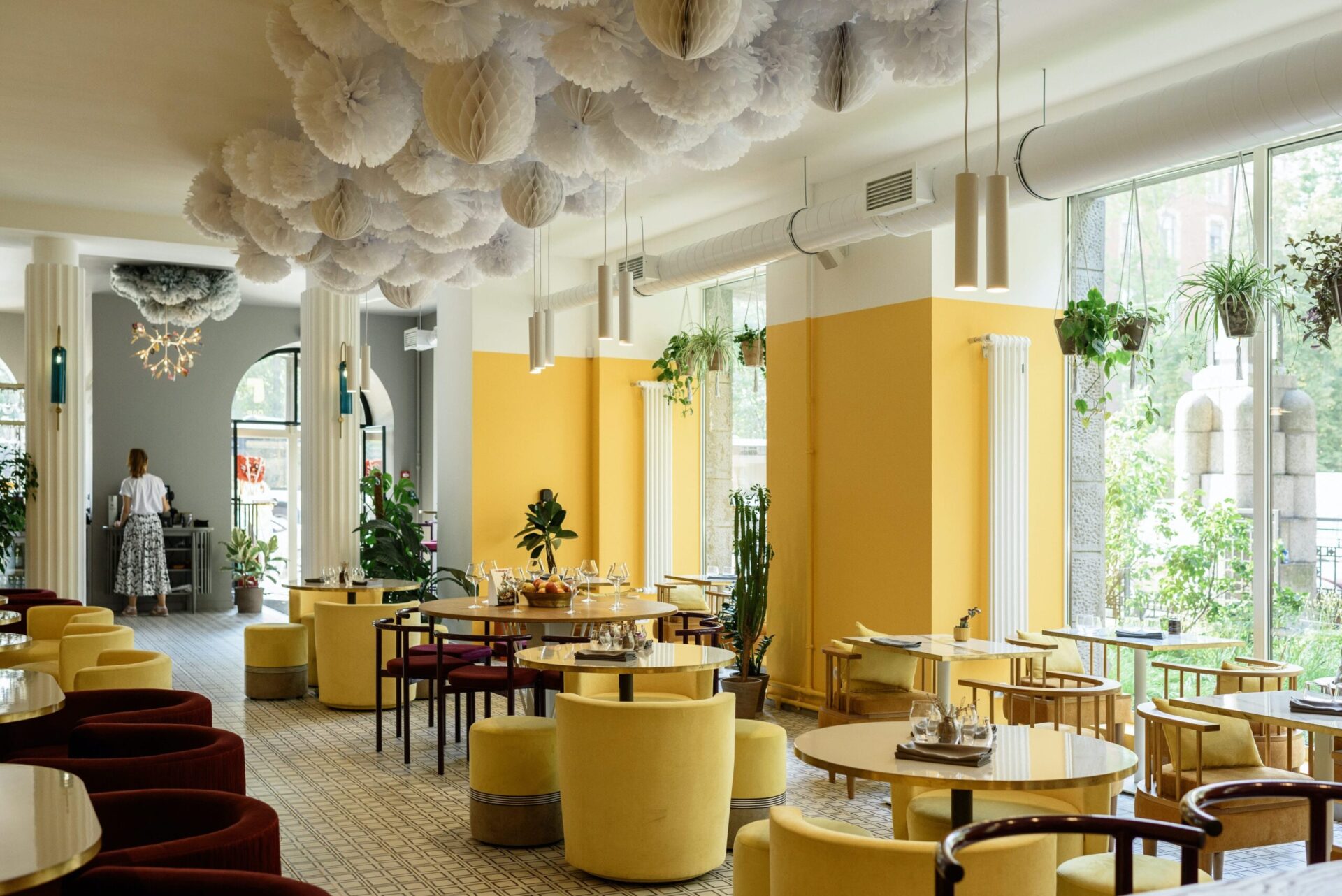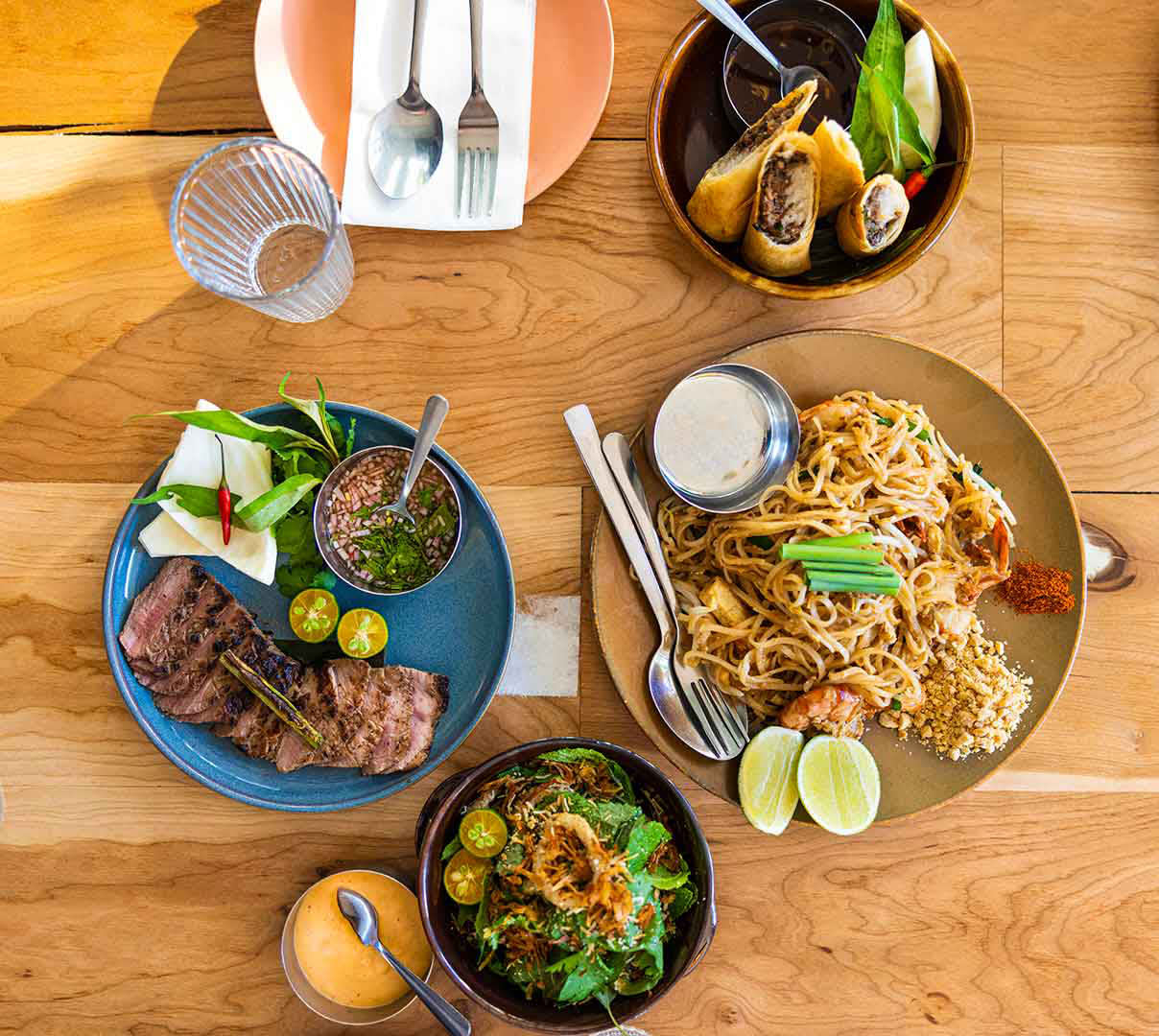Why these food spots are redefining the food culture
Why these food spots are redefining the food culture
Blog Article
Dining Delights: Explore Innovative Restaurants Changing the Food Scene
The contemporary dining landscape is experiencing an impressive makeover, noted by ingenious dining establishments that are redefining cooking standards. From the surge of pop-up facilities accepting seasonal active ingredients to immersive experiences that engage the detects in extraordinary methods, these locations are setting new criteria of what it implies to take pleasure in a dish. In addition, an expanding emphasis on sustainability and local sourcing mirrors a commitment to both quality and neighborhood. As we check out these trends, the inquiry emerges: what future advancements might better reshape our cooking experiences?
The Increase of Pop-Up Restaurants
As the culinary landscape advances, pop-up restaurants have actually become a dynamic pressure, charming food fanatics and entrepreneurs alike. These temporary eating facilities, usually established in non-traditional areas, provide an unique mix of imagination and availability, attracting a varied range of consumers. The surge of pop-up dining establishments can be credited to numerous factors, consisting of the growing demand for unique dining experiences and the business spirit of cooks keen to test their culinary ideas without the financial concern of an irreversible location.Pop-up dining establishments permit cooks to trying out food selections, styles, and motifs, usually concentrating on seasonal or locally-sourced components. This flexibility not just fosters advancement however additionally develops a feeling of necessity, as patrons are drawn to the limited-time offerings. The ephemeral nature of pop-ups cultivates a buzz around the dining experience, encouraging social media sharing and word-of-mouth promotion, which can greatly improve presence and attract a dedicated following.Furthermore, pop-up restaurants typically deal with particular niche markets, varying from vegan and gluten-free choices to ethnic foods, consequently meeting the diverse nutritional choices of contemporary customers. Therefore, these facilities add to the rich tapestry of the food scene, pushing borders and difficult traditional concepts of dining.
Immersive Eating Experiences

Lasting Practices in Cuisine
Welcoming sustainability, cutting-edge dining establishments are redefining their culinary methods to reduce ecological impact while improving the dining experience. These facilities prioritize regional sourcing, frequently teaming up with close-by farmers and producers to assure that active ingredients are fresh and seasonal. This not just minimizes the carbon impact related to long-distance transport however likewise sustains local economies.In enhancement to sourcing, restaurants are significantly embracing techniques that reduce waste. Several are carrying out composting systems and making use of food scraps creatively, transforming what would generally be thrown out right into flavorful components of new recipes. For instance, veggie trimmings can discover new life in stocks or garnishes, while stale bread is repurposed into croutons or bread puddings.Moreover, the trend in the direction of plant-based menus is gaining momentum (Restaurants). By emphasizing vegetables, grains, and legumes, dining establishments can considerably decrease their environmental impact, as plant-based foods generally require less sources and generate less greenhouse gas discharges compared to meat manufacturing. Ingenious chefs are crafting dishes that not only celebrate these components yet additionally supply diners with a remarkable culinary experience.Furthermore, many establishments are adopting environmentally friendly methods such as using eco-friendly packaging for takeout and investing in energy-efficient devices. These measures mirror a dedication to sustainability at every level of procedure, enabling diners to enjoy their dishes with the expertise that their options contribute to a much healthier world. As the food scene continues to develop, the integration of lasting methods comes to be not just a pattern, however a needed standard for the future of eating
Tech-Enhanced Eating Experiences
Tech-enhanced dining adventures are revolutionizing the means customers experience dishes, with over 70% of dining establishments now including electronic advancements to elevate service and involvement. These improvements are not simply trends; they are essential changes that redefine the cooking landscape. From the minute restaurants go into a dining establishment, modern technology is seamlessly woven right into the experience, enhancing both comfort and enjoyment.One of one of the most remarkable developments is the usage of mobile apps for bookings and menu surfing. Restaurants can currently watch detailed descriptions, dietary details, and also the beginnings of active ingredients at their fingertips. This transparency cultivates notified options and permits visitors to customize their dining experience to their preferences.Furthermore, interactive tables equipped with touchscreens offer an appealing platform for getting and amusement. Restaurants can personalize their dishes, discover white wine pairings, or perhaps play games while waiting for their dishes. This integration of technology not only improves the purchasing procedure but also transforms eating right into a vibrant, common activity.Moreover, some establishments are utilizing increased fact (AR) to develop immersive eating experiences. By just directing a smart device at a meal, patrons can envision the active ingredients and cooking techniques in an interesting fashion, bridging the gap between the cooking and electronic worlds.As restaurants remain to welcome these technical technologies, the dining experience comes to be significantly tailored, effective, and delightful. This change reflects a wider pattern towards boosting client engagement, making certain that each meal is not simply regarding sustenance, yet a remarkable journey in dining.
International Flavors With a Twist
The cooking landscape is significantly marked by blend food advancements that mix conventional tastes with unforeseen aspects - Restaurants. Special ingredient pairings not only enhance the eating experience however also admire social heritage, reimagining beloved meals in interesting new means (American Restaurant). This creative strategy invites diners to discover diverse international impacts while experiencing familiar preferences in a fresh context
Combination Food Innovations
Creative thinking in the cookeries has actually led to a vivid rebirth of blend cuisine, where chefs mix diverse worldwide flavors to produce innovative dishes that resist standard borders. This culinary motion goes beyond mere mix, focusing on the unified assimilation of active ingredients and strategies from different cultures.Restaurants focusing on blend cuisine are redefining eating experiences by providing recipes that tell a tale through flavor, method, and discussion. For instance, the marriage of Japanese sushi with Peruvian ceviche has led to one-of-a-kind rolls that celebrate both cooking heritages. Indian spices have actually found their way into Italian pasta recipes, using a wonderful spin on traditional recipes.Chefs are likewise exploring with cooking methods, such as making use of typical frying pan strategies to prepare Latin American stir-fries, therefore creating a rich tapestry of preferences and structures. Seasonal accessibility of components better boosts this innovative process, permitting fresh analyses of classic meals. The attraction of combination cuisine hinges on its ability to shock and pleasure the palate, motivating diners to check out brand-new culinary landscapes while fostering a higher appreciation for the variety of global gastronomy.
Unique Active Ingredient Pairings
Cooking advancement frequently prospers on the unexpected, and one-of-a-kind ingredient pairings go to the center of this fad in the modern-day dining landscape. Cooks are significantly experimenting with combinations that stun and thrill the taste, boosting the dining experience beyond traditional boundaries.For instance, the juxtaposition of wonderful and full-flavored has come to be a characteristic of contemporary food. Breakfast Served Near Me. Consider crunchy duck offered with a cherry and balsamic polish, where the tartness of the cherries matches the splendor of the meat. Recipes including miso-infused delicious chocolate treats display how umami can improve sweetness, producing a balanced flavor account that intrigues diners.Furthermore, the usage of unique flavors in unanticipated contexts, such as saffron in a classic risotto paired with lemon enthusiasm, highlights how culinary boundaries can be redefined. These ingenious pairings not just develop aesthetic and textural contrasts yet also invite restaurants to discover a spectrum of global flavors in a single dish.As dining establishments remain to push the envelope, the adventure of discovering new tastes via unique component pairings guarantees to be a defining feature of the modern food scene, inviting daring eaters to enjoy these imaginative cooking discussions
Social Heritage Reimagined

The Art of Multi-Sensory Foods
In the domain of cooking advancement, multi-sensory meals are revolutionizing the eating experience by intertwining flavor and fragrance in captivating methods. The influence of aesthetic discussion enhances not just the visual charm but likewise the perception of preference, while meticulously curated soundscapes boost the ambiance. Together, these components create an all natural experience that engages all detects, changing how customers connect with food.
Taste and Fragrance Fusion
An expanding number of chefs are accepting the idea of flavor and scent blend, recognizing that a meal is not just a combination of ingredients yet a holistic experience that involves all the detects. This cutting-edge technique highlights the complex partnership in between preference and odor, both of which substantially affect our perception of food.Chefs are trying out various techniques to enhance flavors while all at once crafting fragrant accounts that elevate the eating experience. For instance, using aromatic herbs and spices not just includes depth to recipes but additionally entices the olfactory senses, creating a much more immersive experience. Mixtures, smoke, and essential oils are progressively popular, enabling chefs to adjust scent and boost the general taste profile.Moreover, the tactical pairing of corresponding and contrasting tastes can evoke psychological actions, changing a meal into a remarkable occasion. Restaurants are encouraged to relish each bite, as the interaction of tastes and fragrances unfolds, welcoming them to check out new measurements of preference. This thoughtful amalgamation of sensory components promotes an appreciation for the creativity of food, placing flavor and fragrance combination as a crucial pattern in modern-day gastronomy.
Visual Discussion Impact
Past flavor and fragrance, the visual presentation of a dish plays a critical duty in the total dining experience. The aesthetic appeals of food can evoke feelings, set the tone for the meal, and enhance the expectancy of sampling. Innovative dining establishments are progressively acknowledging that a dish's look can influence visitors' assumptions and satisfaction levels, occasionally even prior to the initial bite is taken.Artful plating techniques, vivid color combinations, and creative garnishes add to a meal's aesthetic allure. Cooks are now trained not simply in cooking abilities, yet additionally in the art of discussion, typically drawing motivation from different creative self-controls. As an example, using unfavorable space in plating helps to create prime focus, enabling the ingredients to shine.Moreover, the fad of multi-sensory meals integrates visual aspects with other senses, such as structure and temperature level, to produce an all natural eating experience. This technique encourages restaurants to involve even more deeply with their food, changing a straightforward dish into a remarkable event. Essentially, the aesthetic presentation of food is not simply a visual endeavor; it is an essential component of the eating experience that can elevate a dish from common to extraordinary.
Soundscapes in Eating
The experience of dining expands beyond the visual aspects of a meal; sound also plays a substantial function fit how food is viewed and enjoyed. Innovative restaurants are significantly discovering the principle of soundscapes-- curated audio atmospheres made to boost the dining experience (American Restaurant). The interplay of noise and taste can greatly affect a person's understanding of taste, structure, and total satisfaction.Research suggests that details audios can enhance or diminish flavors. High-pitched sounds may boost sweet taste, while lower frequencies can increase anger. This sensation has led some cooks and restaurateurs to team up with sound developers, creating one-of-a-kind acoustic backdrops that complement their culinary offerings. Restaurants.In these settings, restaurants might discover themselves engaged in a meticulously crafted sound setting, varying from the gentle rustle of leaves to the rhythmic audios of a dynamic cooking area. Such multisensory dishes not only involve the taste buds however also evoke psychological feedbacks, enhancing the total experience. By taking advantage of the power of noise, these innovative eating facilities are redefining the means we experience food, urging patrons to enjoy each bite while fully engaging their senses
Community-Centric Culinary Efforts
Regularly, ingenious restaurants are redefining their roles within neighborhood areas by executing cooking campaigns that focus on social duty and inclusivity. These establishments are increasingly interesting in methods that not just improve their organization versions however likewise add to the well-being of their neighborhoods.One famous pattern is the establishment of neighborhood kitchen areas that use cooking training and task placement for underserved populaces. These kitchens not only give beneficial skills yet also promote a sense of belonging, empowering people to develop their own culinary courses. Additionally, many restaurants are partnering with regional farms and producers, emphasizing farm-to-table practices that sustain sustainable farming and minimize carbon impacts. This not just ensures quality and top quality however additionally enhances neighborhood economies.Another effort getting traction is the principle of public dining experiences, where varied teams integrated to share meals and tales. This method cultivates understanding and recognition among different cultures, damaging down obstacles and fostering inclusivity. Dining establishments are increasingly adopting waste decrease techniques, such as composting and reusing food scraps, which not only addresses environmental concerns yet additionally encourages patrons to show on their usage behaviors.
Regularly Asked Questions
How Do Innovative Restaurants Preserve Uniformity in Food Quality?

What Are the Expenses Connected With Starting a Pop-Up Dining Establishment?
Starting a pop-up dining establishment entails numerous expenses, including location service, tools acquisitions, permits, advertising and marketing, staffing, and food supplies. Furthermore, business owners ought to allocate unexpected expenses to assure smooth operations throughout the venture's period.
How Do Dining Establishments Pick Their Areas for Pop-Up Occasions?
Dining establishments pick pop-up occasion places based upon target demographics, foot website traffic, availability, and competition. Furthermore, they consider regional market trends and community interaction opportunities to maximize visibility and boost consumer experience throughout the occasion.
What Effect Do Food Trends Carry Dining Establishment Menus?
Food patterns greatly influence restaurant food selections by leading active ingredient choice, affecting dish imagination, and forming customer choices. Facilities frequently adapt to these patterns to improve consumer appeal, preserve competition, and align with developing culinary assumptions.
How Can Diners Assistance Community-Centric Culinary Initiatives?
Restaurants can support community-centric culinary campaigns by patronizing neighborhood dining establishments, getting involved in farm-to-table events, involving with food cooperatives, advertising sustainable techniques, and advocating for plans that reinforce regional food systems like it and improve neighborhood wellness.
Report this page